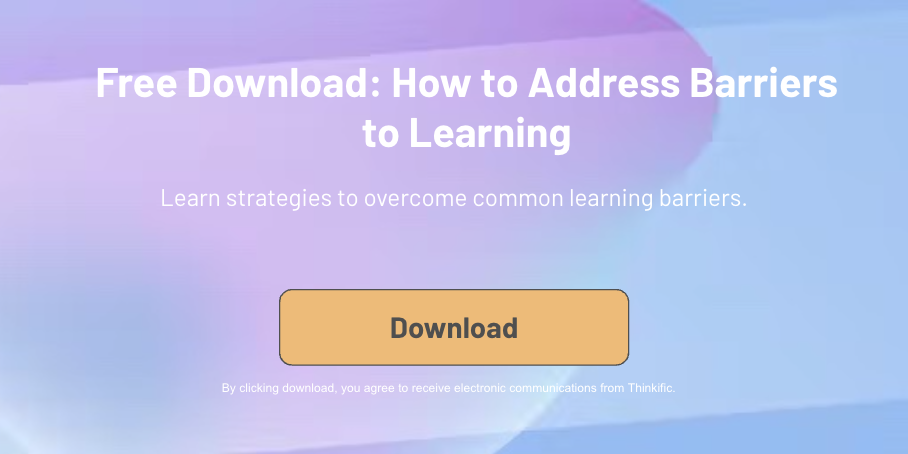You’re about to embark on an exciting new journey – online course creation. Congrats! You’ve made the first of many important decisions. But now, it’s time to think about the next critical aspect – your learners.
As complex human beings, we all respond to different types of learning. No matter if it’s the information itself, how it’s presented, or where we are consuming it, we all have preferences that, if left unconsidered, can cause serious barriers to learning.
Below summarizes the most common barriers to learning and examples that we dive into more detail later on:
| Barriers | Examples |
| School barriers | Elements that can impact a student’s ability to learn at school. |
| Workplace barriers | Elements that can impact an employee’s ability to learn at work. |
| Emotional barriers | Fears, motivation, and other emotions preventing a student from having the confidence to fully immerse themselves in a new learning environment. |
| Environmental barriers | Physical elements, such as workplace distractions, impacting the student’s ability to succeed within their learning environment. |
| Psychological barriers | Conditions that make learning more challenging for students, such as dyslexia, autism, or ADD/ADHD. |
In the remainder of this article, you’ll learn:
- What are learning barriers
- Where we most frequently encounter learning barriers
- How to overcome learning barriers
What are barriers to learning?
First, we’ll begin by covering the basics. What are barriers to learning?
Learning barriers can be physical, mental, emotional, cultural, or social elements that get in the way of a student achieving their learning goals.
Do you ever ask yourself, “what’s the point?” when starting a new school or workplace education program? Or, do you find you learn easier when physically doing the work than sitting in a classroom?
These are just a couple of examples of barriers to learning that impact a student’s ability to understand, retain, and practice the concepts they are trying to grasp. And, we’ll dig into each in just a bit.
Where do we encounter barriers to learning?
When it comes to learning, our physical location plays a significant role in either reducing or promoting common learning barriers. That’s why we most frequently come across learning obstacles at school, work, and home.
Barriers to learning at school
Schools and universities are busy places. For younger students, primary and secondary school environments may look a little different these days – but they are usually bustling with students, teachers, technology, and activities.
However, with constant commotion and varieties of preferred learning (and teaching) styles, schools can present barriers to learning for any student.
Barriers to learning at work
Workplaces with solid corporate cultures inspire employees to take their know-how to the next level with employee training and development programs. Why? Because employee education is proven to boost engagement, motivation, and overall productivity.
However, at work, adults can also encounter barriers to learning if they’re just not fully motivated. Or, sometimes, we can get stuck in our ways and revel in the idea of change.
The first step to addressing these barriers to learning is knowing what they are and who is most affected by them.
Barriers to learning at home
As 2020 brought global shutdowns and stay-at-home orders, our homes became our primary learning environments. Some thrived in a remote setting, whereas others were more challenged.
Available resources, distractions, and emotional and mental well-being all played a role in adapting to our new environments. Now, as more businesses and, in some locations, schools adopt a hybrid approach, our homes are becoming commonplace for encountering learning obstacles when we don’t have the right tools or support.
Most common types of barriers to learning (and how to overcome them)
Barriers to learning aren’t segmented to certain places or locations. They can pop up almost anywhere a student is attempting to learn or do something new.
And, no matter if you’re targeting a seasoned employee with decades of experience or a freshman at your local university – we all experience learning barriers, and we can overcome each one.
Here are some of the most common barriers to learning with helpful tips on conquering each of them.
1. Motivation
At one point or another, we all hit that 2:30 motivation drag. And depending on your environment or corporate culture, it can be challenging to drum up the energy to learn when you don’t have the right support.
Those are a few of the many reasons motivation is one of the most common barriers to learning. Inspiration, distraction, drive, and interest can all impact a student or employee’s enthusiasm to learn something new.
How to optimize this: motivate your students to learn with gamification. Gamification capabilities – like leader boards, rewards, puzzles, and quizzes – create a more immersive experience that incentivizes your audiences to kick their learning into gear. Check out some of the student experience apps located in Thinkifc’s App Store.
2. Lack of previous knowledge
If you have a college degree, you likely had to take pre-requisite courses before launching into some of your more specific classes. That’s because you can’t snap your fingers to become a master chef without learning the basics of various cooking methods, utensils, and ingredients.
So, when a new student takes your course without having access to the base knowledge beforehand, it can deter them from engaging in or completing the session entirely.
How to overcome this learning barrier: Design your course with a learning path in mind, and use learning sequences. With learning sequence, you are essentially designing your courses in reverse order. So, you’re starting with your end goal and mapping out the pre-requisite concepts your students need to become familiar with to achieve that objective.
3. Learning challenges
Did you know that more than one billion people worldwide have a learning difference that can make online learning harder for them? Or that 10% of the population have dyslexia and autism?
Learning differences are a common barrier for students looking to expand their knowledge or skillsets. This is why it’s so important to ensure your online academy has tools and capabilities that make learning more accessible to everyone.
How to overcome this learning barrier: be aware and remove obstacles that can prevent your students from engaging fully. Use Universal Design for Learning (UDL) best practices to level the playing field for all learners. For example:
- Make sure any recordings or videos are accessible with subtitles, closed captions, or text-based alternatives for those with hearing impairments and learning challenges.
- Some learning challenges may require more personal interaction, providing audiobooks, and typing on a computer or tablet instead of writing.
- Include clear, step-by-step instructions and offer multi-sensory options for learners to self-select a method that works well for them.
- You can help students with ADHD by giving them more time on tests, allowing for breaks and time to move around, and using organizational tools to limit the number of things they need to track.
The key is providing options. The more diversity in your content options, the more you’ll be able to appeal to many different types of learners. And, don’t forget to ask for feedback to see where you can improve.
4. Learning environment
Your surroundings can make or break a learning experience. As we talked about before, schools, workplaces, and even our homes are busy places with many distractions. Those distractions don’t necessarily make for the most conducive environment to concentrate on your learning, which ultimately creates a barrier to fully expanding your skills.
How to optimize this: remember to create a professional learning community (PLC). PLCs aren’t just open to educators. People join these communities for support, engagement, and building relationships that inspire them to learn. With the right platform, PLCs are excellent resources for helping students zone in on their learning and quiet the chaos around them.
5. Emotional factors
Sometimes, barriers to learning start from within. Being afraid of failing, past insecurities, or fear of change can ignite uncomfortable emotional states that prevent students from taking full advantage of the learning opportunities in front of them.
How to overcome this: reinforce some of these insecurities with rewards and certificates. Course creators can quickly win over uneasy learners by rewarding their efforts through gamification capabilities or completion certificates that celebrate their success.
6. Learning styles
There is no universal way of teaching that appeals to every single student. Some learn easier with visual cues, whereas others respond better to symbols, auditory repetition, or music.
With online learning and the right learning management system, course creators can access dynamic capabilities right at their fingertips to create content that appeals to a wide variety of learners.
How to optimize this: build content for different learning styles. Different course elements will appeal to different types of learners – so remember to mix it up!
7. Overall presentation
Have you ever received a 2,000-word long email? That would be longer than this article. Our guess is you didn’t read all of it – or maybe even most of it. Why? Because, for that level of detail, email is the wrong presentation.
In 2000, the average person’s attention span was 12 seconds. That is now 8 seconds. This means the presentation is everything if you’re going to capture your audience and engage them in your learning content.
How to optimize this: adopt the principles of Universal Design for Learning (UDL). With UDL, learning courses focus on engagement, representation, and action and expression to attract and maintain user attention.
8. Learning experience
When it comes to learning, oftentimes, the experience outweighs the content itself. For example, listening to an instructor with limited interaction will not be the right experience for you if you’re a hands-on learner. The same applies to the information itself – highly complex topics are better communicated through dynamic visuals than text-based materials.
As a result, learning barriers can quickly come up if the overall experience doesn’t meet the students’ needs.
How to optimize this: apply learning experience design to your online courses. Learning experience design combines the concepts of instructional design and user experience design to create a user-centric approach that helps students achieve their goals as quickly as possible. With learning experience design, you can create a unique experience with social engagement, multimedia, and hands-on learning that keeps students coming back.
Pro tip: It also helps to brush up on cognitive load theory to understand how things like dense content, bulky packaging, and lazy processing can impact your students’ learning experiences.
Conclusion
When starting your online course development, it is essential to start by understanding your most important audience – the students themselves. Knowing who they are, how they learn best, and what they need to excel will help you break down common learning barriers and create a memorable learning experience for everyone.
Thinkific’s online learning tools make it easy to create a learning experience that supports learners of all abilities – get started for free, or book a call with our Solutions team to learn more about our enterprise solutions.









